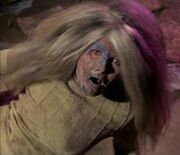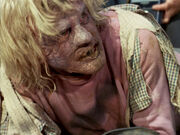A life prolongation project was an ambitious bioengineering attempt to develop a means of extending the life span of a lifeform.
On Miri, circa Earth year 1960, scientists worked on a life prolongation project in which they endeavored to create a series of viruses that they could use to extend the life span of a cell far beyond normal [i.e. aging only one month every 100 years]. This work, however, resulted in a virus that quickly became an epidemic, killing the planet's adult population. Children were granted the extended life span, but the onset of puberty caused the virus to manifest its fatal symptoms.

Early stage blemish

Mid-stage infection

Progressing infection

Puberty stage

Terminal stage
The Onlies, feral children still alive on the planet in 2266, demonstrated that the complex did prolong the lives of children; these individuals had been born about three hundred years earlier, and had not aged much in the interim. But the complex had a fatal flaw: it killed adults.
The complex killed all the adults on Miri's world – they developed a rapidly progressing, extremely debilitating disorder of the metabolism from which no anatomical system was spared. Children developed this form when they began entering puberty. While Humans are vulnerable to this disease, Vulcans are not, although they can be carriers.
The first symptoms of the complex are cosmetic: inflamed bluish blemishes with red margins appeared. In some individuals, these blemishes appeared within hours of exposure. Within a few days, internal symptoms developed: intense fever, severe pain in the extremities, and blurred vision.
Emotional instability and extreme irritability were the hallmarks of the middle stage. Early symptoms grew more pronounced, with higher fevers and larger, darker blemishes. These symptoms appeared within two or three days of onset; those older when infected experienced a more rapid progression.
In the end stages, about seven days after onset, blemishes covered the entire skin surface, the metabolism ran very rapidly and the sufferer became completely insane. Individuals in this stage attacked anyone they found, and destroyed their surroundings. The metabolic dysfunction left them weakened; in this stage, even a phaser set to stun could be fatal. The resulting "grups" were barely recognizable as Human. The Onlies saw all grown-ups become these creatures, consequently, they developed a profound fear of and deep distrust for adults.
Notes left behind from the project, in a laboratory which had been used by the project scientists, provided Doctor McCoy, of the USS Enterprise, vital clues necessary to develop an effective vaccine in 2266. At the time, he was out of communication with his ship, and so elected to try the vaccine on himself, without testing it. Fortunately, it worked as expected, although not without side effects of pain and unconsciousness. (TOS: "Miri")
Background information[]
The term "life prolongation project" is referred to only once in on-screen dialogue. In the final draft script of "Miri", this line instead referred to "life prolongation experiments". The same script also established the project as having been conducted in government buildings, though no government is mentioned in the final version of the episode.
In a scripted but ultimately unused captain's log, Captain Kirk reported, "From the records and files we can find, the pattern of experiments conducted in this lab indicate that the scientists working here were attempting to slow down the growth and aging processes by changing the effect of chemical particles on each other." Immediately thereafter, Spock was to have been shown commenting that the experiments apparently operated on a specific time table, which the landing party hadn't been able to locate, and that the sequence of experiments was missing too. He speculated the absence of that sequence was for security reasons, as he suspected it had been kept elsewhere.
Inspecting a blemish on his arm, McCoy was scripted to then remark about the disease, "If I tried to describe this in a report, they'd think I was mad." Spock later stated, "Apparently they [the scientists] thought they had the factors so worked out that all the cells, in all living beings, would develop some equally new antibodies, with the end result that the cells themselves would… live almost forever."
Near the end of the script, Kirk referred to the virus as a time bomb, which was "set, sure to go off," and "ticking." Not only are these lines not in the final version of the episode but McCoy, in fact, does indeed voice an audio report about the virus on-screen, speaking into a communicator.
Jason Isaacs referred to the virus as "Grup disease" and "a wasting disease that is actually purple plasticine." The illness gave him nightmares during his childhood. "Little did I know as a kid, it's an allegory for the horrors of puberty," he observed. "But, to [boyhood] me, it's just a disease that kills you, which is what's great about Star Trek, when it works on many different levels." [1]
